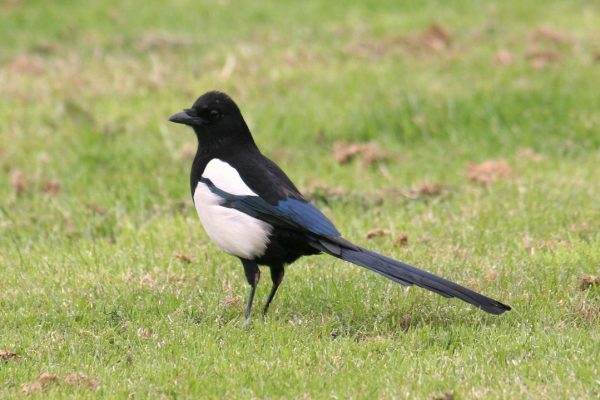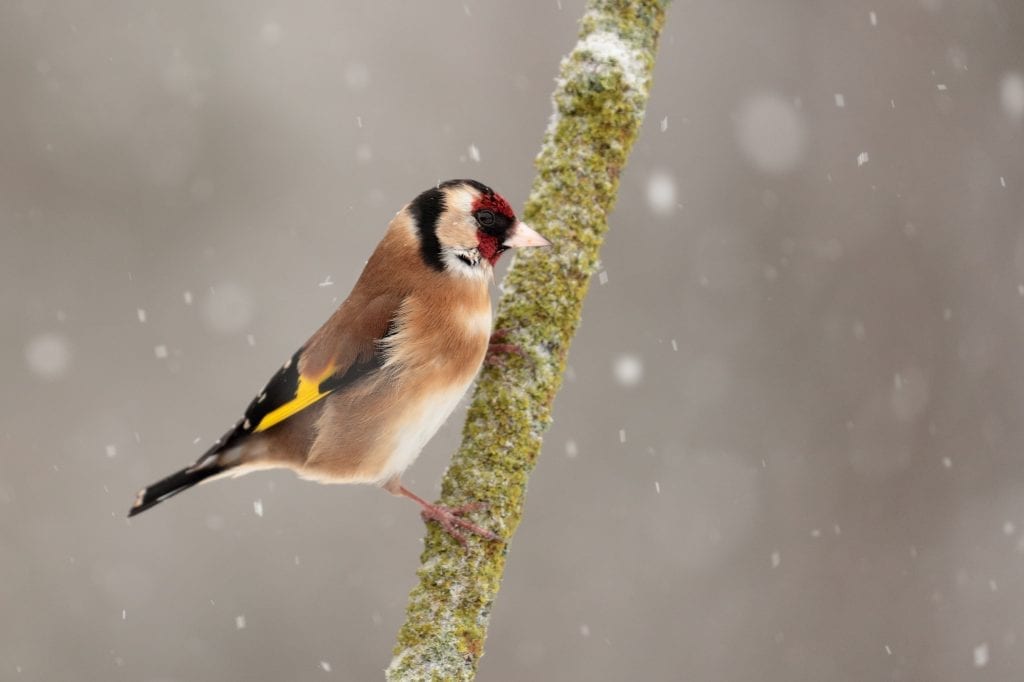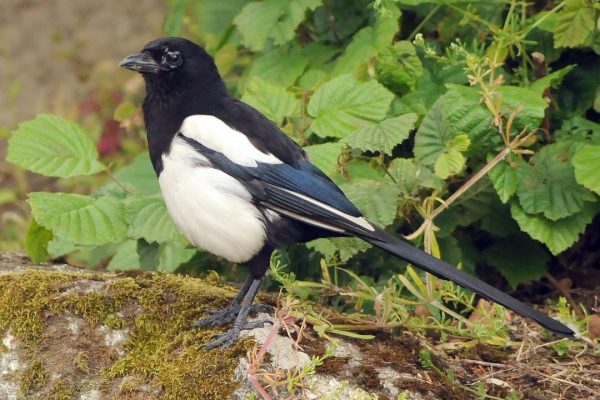
Magpie
| Irish Name: | Snag breac |
| Scientific name: | Pica pica |
| Bird Family: | Crows |
green
Conservation status
Conservation status
Status
Resident. One of Ireland's Top 20 most widespread garden birds.
Identification
A species of crow. All crows have sturdy legs and strong bills and are intelligent and social in nature. Very easy to tell apart from any other bird. Boldly marked in black and white with a very long tail. The head, chest, back and tail are black; the belly and flanks are white. Shows white outer wings which contrast strongly with black and white on the inner wings. Plumage can show a green or blue gloss depending on the light. Short, stout, black bill. Longish black legs which are used for both walking and bounding. Juvenile birds are very similar to adults but lack the long tail, which takes a while to grow. Flight is fluttering and direct. Noisy flocks, know as 'Magpie parliaments' can form.
Voice
Harsh and unmusical. Often repeated in alarm.
Diet
Takes a wide variety of food types, very opportunistic in its feeding habitats. Foods include invertebrates, fruits, seeds, small vertebrates, carrion, refuse, and scrapes. Will sometimes take the eggs and young of small birds. Feeds in a variety of situations including - pastures and cereals in farmland, parks and garden in urban situations, also visits bird tables, frequents water sides and
Breeding
Nests in trees in a large conical nest. Breeds in trees and woodlands, both coniferous and deciduous, in the countryside and also in urban areas. Magpies are found throughout the country in high densities, only on parts of the west coast are they less numerous.
Wintering
Wintering distribution is not substantially different from its breeding distribution.
Monitored by
Blog posts about this bird

35th Irish Garden Bird Survey is ready to take flight
Birds inject a huge amount of joy into our lives, creating the soundtrack to spring mornings and brightening up our gardens on otherwise drab winter days.
As we approach what is widely considered the “season of giving”, one surefire way to give back to the birds for all that they do for us is to participate in this year’s Irish Garden Bird Survey – the most popular and longest-running citizen science survey in Ireland.

 Last year, the Robin came out on top again in Irish gardens having been seen in 99% of gardens, though were pushed to second place by the Blackbird in counties Wicklow, Offaly, Kildare and Antrim. The mild weather over the majority of last winter meant that many species were similarly widespread as in previous winters. In addition to Robin and Blackbird, Blue Tits and Magpies both occurred in over 90% of Irish gardens, while Great Tit, Chaffinch, House Sparrow and Goldfinch were in over 80% of gardens. For House Sparrow, it was their second-best year on record, likely due to a bumper breeding season. The species is on the ‘Amber list’ of Birds of Conservation Concern, so this positive trend is to be welcomed.
Though the winter weather was mostly mild, there were a few short spells of snow which drove birds into gardens in higher numbers. The first species affected by this are often the birds in the thrush family, including our resident Song Thrush and Mistle Thrush, migrant Redwing from Iceland and Fieldfare from Scandinavia.
“Despite the temperatures being mild overall, we seem to be getting more storms and multiple short snowy spells in recent years, and these can be enough to deplete birds’ fat reserves and put them under real pressure. Song Thrush occurred in an extra 12% of gardens last year owing to the snowy weather” said Burke. “So, these are the times when your garden birds really need you to provide food and water, and if you can put these out a few days before any snow hits then you’re giving the birds a chance to realise it’s there, so they know exactly where to go when the ground freezes over.”
Last year, the Robin came out on top again in Irish gardens having been seen in 99% of gardens, though were pushed to second place by the Blackbird in counties Wicklow, Offaly, Kildare and Antrim. The mild weather over the majority of last winter meant that many species were similarly widespread as in previous winters. In addition to Robin and Blackbird, Blue Tits and Magpies both occurred in over 90% of Irish gardens, while Great Tit, Chaffinch, House Sparrow and Goldfinch were in over 80% of gardens. For House Sparrow, it was their second-best year on record, likely due to a bumper breeding season. The species is on the ‘Amber list’ of Birds of Conservation Concern, so this positive trend is to be welcomed.
Though the winter weather was mostly mild, there were a few short spells of snow which drove birds into gardens in higher numbers. The first species affected by this are often the birds in the thrush family, including our resident Song Thrush and Mistle Thrush, migrant Redwing from Iceland and Fieldfare from Scandinavia.
“Despite the temperatures being mild overall, we seem to be getting more storms and multiple short snowy spells in recent years, and these can be enough to deplete birds’ fat reserves and put them under real pressure. Song Thrush occurred in an extra 12% of gardens last year owing to the snowy weather” said Burke. “So, these are the times when your garden birds really need you to provide food and water, and if you can put these out a few days before any snow hits then you’re giving the birds a chance to realise it’s there, so they know exactly where to go when the ground freezes over.”
 Some very rare species were spotted in small numbers in Ireland last winter such as Bramblings, Lesser Whitethroats, Black Redstarts, Snow Buntings and Ring-necked Parakeets.
Some very rare species were spotted in small numbers in Ireland last winter such as Bramblings, Lesser Whitethroats, Black Redstarts, Snow Buntings and Ring-necked Parakeets.
35 years of the Irish Garden Bird Survey
Now in its 35th year, the Irish Garden Bird Survey grants people across the country the opportunity to serve as our eyes on the ground by observing and recording birds in their gardens, on school grounds, on their balconies, or within any other space they enjoy daily. All of this information gives us insight into how different species are faring and, in turn, helps us to identify current threats and future conservation priorities.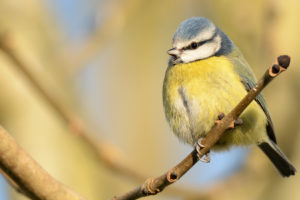
Blue Tit. Photo: Brian Burke.
The Irish Garden Bird Survey is perhaps our most simple and inclusive survey, one in which people of all ages, backgrounds and experience levels can play their part. In fact, it is so simple that, whether or not you have heard of the Irish Garden Bird Survey, it is likely that you are already doing the work. “The Irish Garden Bird Survey is something you can do with a cup of tea looking out the window. You can do it as you're washing the dishes or filling the kettle. People are always watching their garden birds during the winter anyway. That’s when the garden bird numbers peak. The birds are driven to gardens to look for food and people might be inside a lot more because the weather isn’t as good,” says Coordinator of the Irish Garden Bird Survey, Brian Burke. “As we always tell people, you are probably doing this anyway. We just are asking you to go that extra step by writing down and sending us what you see.” While participating in the Irish Garden Bird Survey does not take a lot of time or effort, the impact of the data collected by participants over the past 35 years has been huge. Thanks to them, we now know that Robins, Blackbirds and Blue Tits are the most common garden bird species in Ireland. We know that species such as Great Spotted Woodpecker are on the rise. We know that the breeding Greenfinch numbers have plummeted by 48 per cent in recent years, a loss that can be almost entirely linked to trichomoniasis – a fatal disease caused by a microscopic parasite which predominantly affects finches.2022/ 2023 Irish Garden Bird Survey Results
While there is some consistency in terms of what species are most common, cold winter weather, autumn food supplies, and the success of the summer breeding season just gone all play a part in what birds arrive in Irish gardens at this time of year. Last year, the Robin came out on top again in Irish gardens having been seen in 99% of gardens, though were pushed to second place by the Blackbird in counties Wicklow, Offaly, Kildare and Antrim. The mild weather over the majority of last winter meant that many species were similarly widespread as in previous winters. In addition to Robin and Blackbird, Blue Tits and Magpies both occurred in over 90% of Irish gardens, while Great Tit, Chaffinch, House Sparrow and Goldfinch were in over 80% of gardens. For House Sparrow, it was their second-best year on record, likely due to a bumper breeding season. The species is on the ‘Amber list’ of Birds of Conservation Concern, so this positive trend is to be welcomed.
Though the winter weather was mostly mild, there were a few short spells of snow which drove birds into gardens in higher numbers. The first species affected by this are often the birds in the thrush family, including our resident Song Thrush and Mistle Thrush, migrant Redwing from Iceland and Fieldfare from Scandinavia.
“Despite the temperatures being mild overall, we seem to be getting more storms and multiple short snowy spells in recent years, and these can be enough to deplete birds’ fat reserves and put them under real pressure. Song Thrush occurred in an extra 12% of gardens last year owing to the snowy weather” said Burke. “So, these are the times when your garden birds really need you to provide food and water, and if you can put these out a few days before any snow hits then you’re giving the birds a chance to realise it’s there, so they know exactly where to go when the ground freezes over.”
Last year, the Robin came out on top again in Irish gardens having been seen in 99% of gardens, though were pushed to second place by the Blackbird in counties Wicklow, Offaly, Kildare and Antrim. The mild weather over the majority of last winter meant that many species were similarly widespread as in previous winters. In addition to Robin and Blackbird, Blue Tits and Magpies both occurred in over 90% of Irish gardens, while Great Tit, Chaffinch, House Sparrow and Goldfinch were in over 80% of gardens. For House Sparrow, it was their second-best year on record, likely due to a bumper breeding season. The species is on the ‘Amber list’ of Birds of Conservation Concern, so this positive trend is to be welcomed.
Though the winter weather was mostly mild, there were a few short spells of snow which drove birds into gardens in higher numbers. The first species affected by this are often the birds in the thrush family, including our resident Song Thrush and Mistle Thrush, migrant Redwing from Iceland and Fieldfare from Scandinavia.
“Despite the temperatures being mild overall, we seem to be getting more storms and multiple short snowy spells in recent years, and these can be enough to deplete birds’ fat reserves and put them under real pressure. Song Thrush occurred in an extra 12% of gardens last year owing to the snowy weather” said Burke. “So, these are the times when your garden birds really need you to provide food and water, and if you can put these out a few days before any snow hits then you’re giving the birds a chance to realise it’s there, so they know exactly where to go when the ground freezes over.”
 Some very rare species were spotted in small numbers in Ireland last winter such as Bramblings, Lesser Whitethroats, Black Redstarts, Snow Buntings and Ring-necked Parakeets.
Some very rare species were spotted in small numbers in Ireland last winter such as Bramblings, Lesser Whitethroats, Black Redstarts, Snow Buntings and Ring-necked Parakeets.
Getting involved in the survey
The value of an individual’s participation in the Irish Garden Bird Survey is not dependent on their bird knowledge, location or garden size but rather, their willingness to get involved every winter. “The value of the survey is when people do it year after year because we can monitor the change then. It doesn’t matter if you have three species in your garden and someone else has 30, we want to find out how those three species fare over time. That is the real crux of the survey,” explains Brian. “We want to hear from people with and without feeders. We want results from every type of garden in the country so that the survey results are representative of the whole country.”Goldfinch. Photo: Dick Coombes.
The Irish Garden Bird Survey is once again sponsored by Ballymaloe, whose support in recent years has helped ensure the survey has gone from strength to strength, improving monitoring at national level and allowing for greater focus on conservation issues facing individual species. “United in our commitment to the environment and inspired by the legacy of our forefather, Ivan Allen, Ballymaloe businesses as a group proudly sponsor BirdWatch Ireland's annual Irish Garden Bird Survey. Mr Ivan Allen, the husband of Myrtle Allen and a devoted lover of birdlife, cherished the natural habitat around Ballymaloe House, and practised sustainable farming way ahead of his time. In his memory, our collective support for the Irish Bird Survey reflects our ongoing celebration of Mr Allen's passion for birdlife and commitment to conservation,” said Marketing and Digital Manager at Ballymaloe House Hotel, Helen Cuddigan. “Together Ballymaloe House Hotel, the Ballymaloe Cookery School and Ballymaloe Foods are honoured to contribute towards supporting the preservation of Irish birdlife via BirdWatch Ireland's important national Irish Garden Bird Survey initiative in his name. We encourage as many households as possible to get involved, every entry helps BirdWatch Ireland protect birdlife on the island of Ireland.” Participating in the Irish Garden Bird Survey each winter is a simple and effective way of contributing to a crucial body of data that will help to guide conservation. Through taking part, you are also sure to reap many rewards as the survey offers an opportunity to increase your bird knowledge, take a daily pause and perhaps, create memorable moments with friends and family. The Irish Garden Bird Survey will kick off on Monday, November 27th. For instructions on how to take part, see the Irish Garden Bird Survey page on our website here.
'Last Christmas' - Birds in Irish Gardens last winter
There's still time to take part in the Irish Garden Bird Survey!! See here for more details.
 If you’re a BirdWatch Ireland member you’ll have already read the results of last year’s survey in your winter edition of Wings magazine. If you’re not a member, please join and support our work! But you can catch up on last year’s Irish Garden Bird Survey results with the overview below. If this is your first year to take part in the survey, don’t worry about knowing every single species that might appear in your garden – just familiarise yourself with the most common ones to start off. If you’re a survey veteran, then see how your garden bird list compares to the national average!
If you’re a BirdWatch Ireland member you’ll have already read the results of last year’s survey in your winter edition of Wings magazine. If you’re not a member, please join and support our work! But you can catch up on last year’s Irish Garden Bird Survey results with the overview below. If this is your first year to take part in the survey, don’t worry about knowing every single species that might appear in your garden – just familiarise yourself with the most common ones to start off. If you’re a survey veteran, then see how your garden bird list compares to the national average!

Over 90% of Irish Gardens
The species at the top of the list didn’t change much from previous years. Robin, as per usual, was on top, followed by Blackbird and Blue Tit. Great Tit and Magpie moved up a place each into 4th and 5th, thanks to a fall in the numbers of Chaffinch reported. Robins can still be territorial in the winter, so are pretty evenly spread across the country, while our Blackbird population is topped up by hundreds of thousands of migrants from Scandinavia in the winter, hence their high-ranking each year. Blue Tits and Great Tits are pretty ubiquitous too, and Magpies are very effective at exploiting both urban and rural habitats.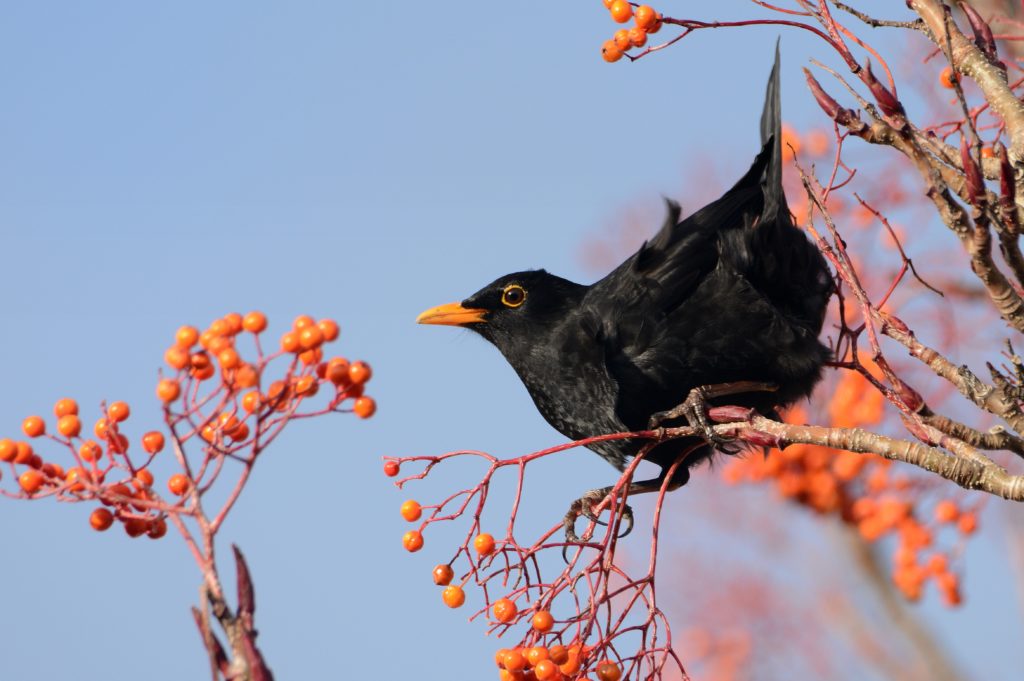
80-90% of Irish Gardens
Chaffinch and Goldfinch fell two and three places to 6th and 10th respectively, since the previous winter, and those declines were greatest in urban and suburban gardens rather than rural ones. On the back of a great breeding season, Coal Tit moved up three places to 7th place. House Sparrows kept 8th position, and Starling made it into the top 10 garden birds for the first time in a decade!
50-80% of Irish Gardens
Wren dropped two places to 11th, while species such as Dunnock (12th), Rook (16th), Collared Dove (17th) all stayed in the same position as the previous winter. When a winter is pretty mild (the occasional storm excluded) we tend to see this stability in the rankings across many species. There was some slight movement for Woodpigeon (14th), Jackdaw (15th) and Hooded Crow (19th), all of which fell one place. The mild weather tends to mean these species aren’t forced to retreat to gardens for food as much as in other winters. Song Thrush increased by around 2% and jumped to places in the rankings to 13th. Pied Wagtail rose up two places to 18th and occurred in >7% more gardens than they did on average over the preceding five year period. Despite being very common in towns, cities and shopping centre carparks, they’re actually seen in twice as many rural gardens as urban or suburban ones. Greenfinch continue to suffer the devastating effects of trichomoniasis (make sure to clean your feeders regularly!) and reached a new low for the species in the survey – 20th place.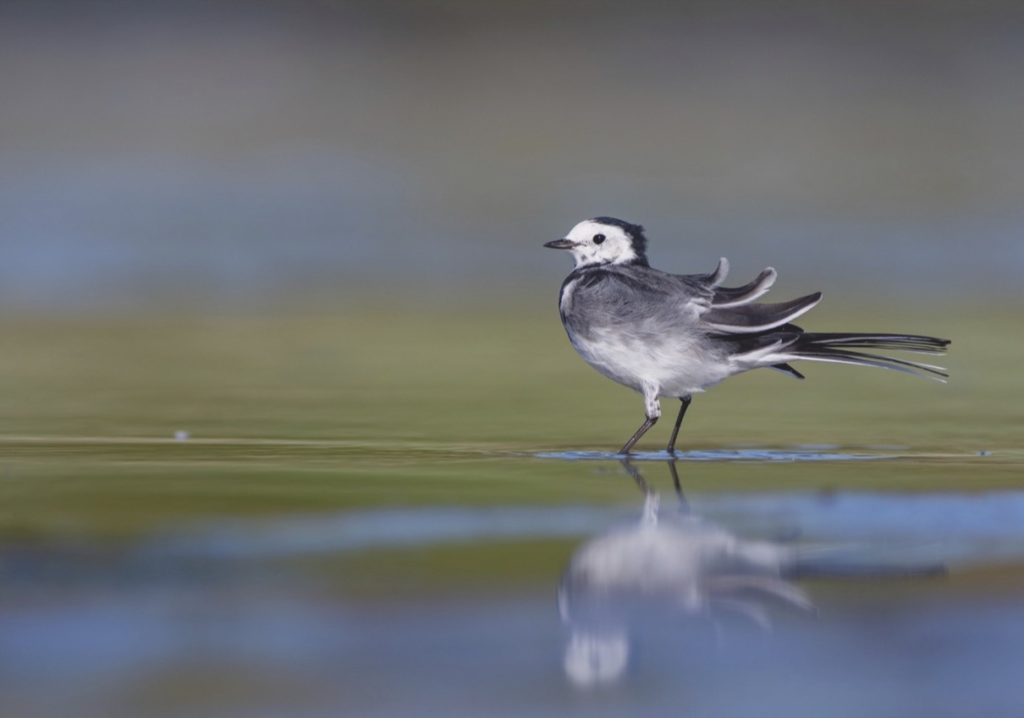
20-50% of Irish Gardens
While the above species occur in more than 50% of gardens, you’re in the minority if one of the below appears in your garden this winter: Siskin jumped up 7 places (8%) since the previous year. They usually start to appear in gardens from mid-January onwards, but they were making appearances from late November right through to March in most parts of the country last winter. No other species made such a big jump pup the table! One of the bigger losers was Goldcrest - down 5 places to 29th, a decrease of nearly 8%. It was a mild winter, and a good breeding season for most species in 2020, so the reason for this isn’t immediately obvious. Bullfinch dropped three places to 24th, but this might just be due to the mild winter and abundance of feeding options in the wider countryside, as they’re not a bird that visits feeders and so aren’t as associated with gardens as other finches. Other species in the 20-50% band include Blackcap, Long-tailed Tit, Sparrowhawk, Mistle Thrush and Feral Pigeon. Again, not species that tend to avail of bird feeders with any regularity, but species who know how to make a good living in a human-dominated landscape, be it rural, urban or suburban.Best of the rest
Despite being a non-native species, Pheasants tend to be seen in 15-20% of gardens each year, which is surprisingly high considering they don’t tend to breed well in the wild, so are reliant on being released by gun clubs every autumn. Buzzards moved two places up the rankings and are seen over 15% of gardens each winter. Herring Gulls were in 11% of gardens, Black-headed Gulls in 4%, and 1.3% of gardens had some sort of gull visiting but weren’t sure what species! Great Spotted Woodpeckers are one of the most recent additions to our bird community, and over 4% of gardens had one visiting their peanut feeders (it’s always peanut feeders!) last winter. They’re now breeding in almost every county in Ireland, so expect to see them charging up the rankings table in the coming years. Last year was a mast year for acorns, which meant Oak trees were providing a huge bounty for species such as Jays, and as a result they were seen in fewer gardens than usual (8%, down 1% from the average). This tends to happen every few years. Lastly, Redwing and Fieldfare, our two wintering thrush species, both dropped a bit, thanks again to the mild winter.
 See below for the full Top 30 birds in Irish gardens last winter, and their various ups and downs since the previous year. Most gardens record between 10 and 25 species over the course of a winter. Whether you have more or less than that, we still need you do to the survey!
See below for the full Top 30 birds in Irish gardens last winter, and their various ups and downs since the previous year. Most gardens record between 10 and 25 species over the course of a winter. Whether you have more or less than that, we still need you do to the survey!




We are hugely grateful to Ballymaloe for their sponsorship and support of the Irish Garden Bird Survey.
For more details about the Irish Garden Bird Survey click here, or download the survey form below.




